Small but mighty, bees are some of the most important animals in the world because of their role in pollinating crops and flowers. In fact, the very survival of numerous other animals is down to bees, as without them, plants wouldn’t grow and crops would fail. However, although you may instantly think of bees as the classic black and yellow color, there are many different bees around. In fact, there are approximately 20,000 species of them, and these can be grouped into many different “types” — such as bumble bees and honey bees. So, let’s discover some of the best-known types of bees and how to identify them. We will also explore what makes them so unique!

1. Bumble Bees (Bombus spp.)
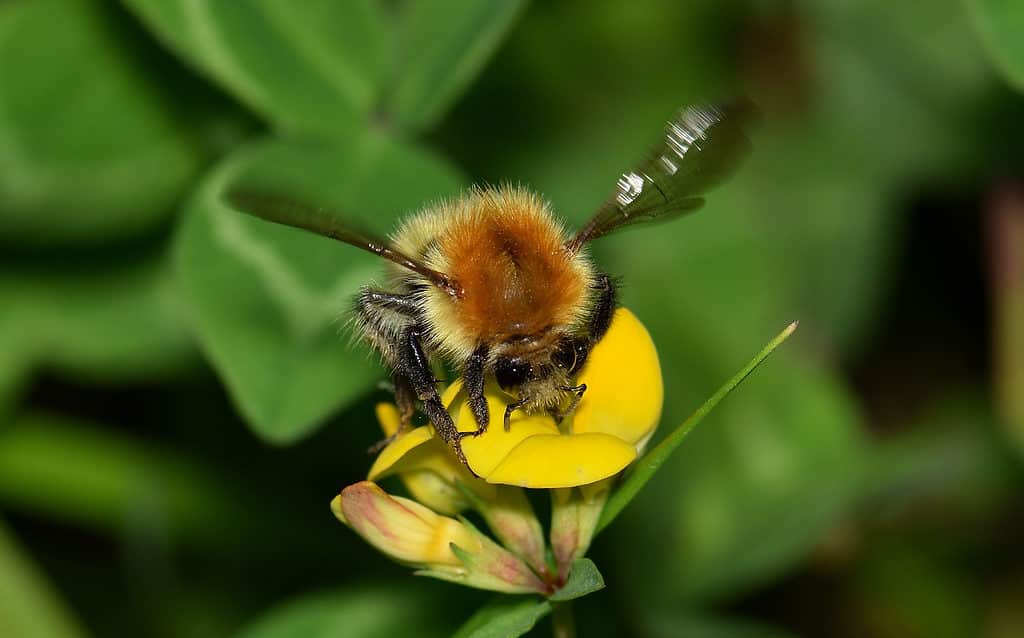
Bumblebees are important pollinators, particularly of agricultural crops and wildflower meadows.
©iStock.com/Wirestock
First, we have bumblebees, members of the Bombus genus. There are around 250 species of bumblebees, and they are distributed across temperate climates. Although their appearance of them can vary somewhat between species, most bumblebees are characterized by their plump and furry appearance. They are typically 0.6-1 inch long, and most have alternating bands of black and yellow on their abdomens. Their bodies are covered with dense hair or pile, and this means that they are well adapted to living in slightly cooler climates than some of the other types of bees. Bumblebees are incredibly important pollinators, particularly of agricultural crops and wildflower meadows. One of the reasons that they are such good pollinators is that the pollen sticks very easily to their hairy bodies.
2. Carpenter Bees (Xylocopa spp.)
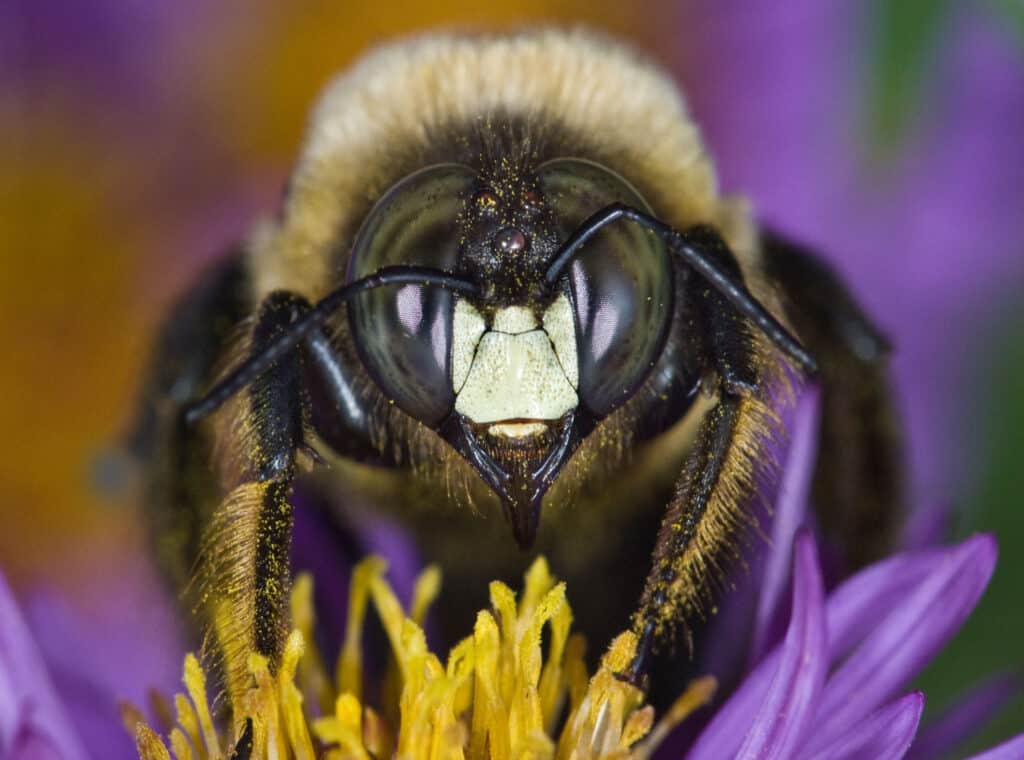
Although carpenter bees may look like bumblebees at first glance, they don’t have body hair.
©Gerry Bishop/Shutterstock.com
Some of the most fascinating bees around are carpenter bees, so named because of their nesting behavior. This is because carpenter bees typically always nest in wood, bamboo, or other hard plant material. Carpenter bees create their nests by burrowing into wood. In fact, nest sites can even include rafters, fascia boards, or decks. They don’t eat the wood, but their burrowing behavior can seriously undermine the strength of structures — resulting in their being classed as pests in some cases. They are typically solitary bees, although sometimes females can cohabit. Carpenter bees are large bees and can resemble bumblebees at first glance. However, carpenter bees are usually entirely black. They also lack the body hair that bumblebees have; instead, they have smooth and shiny bodies. Additionally, male carpenter bees often have small white markings on their head, while females do not.
3. Honey Bees (Apis spp.)
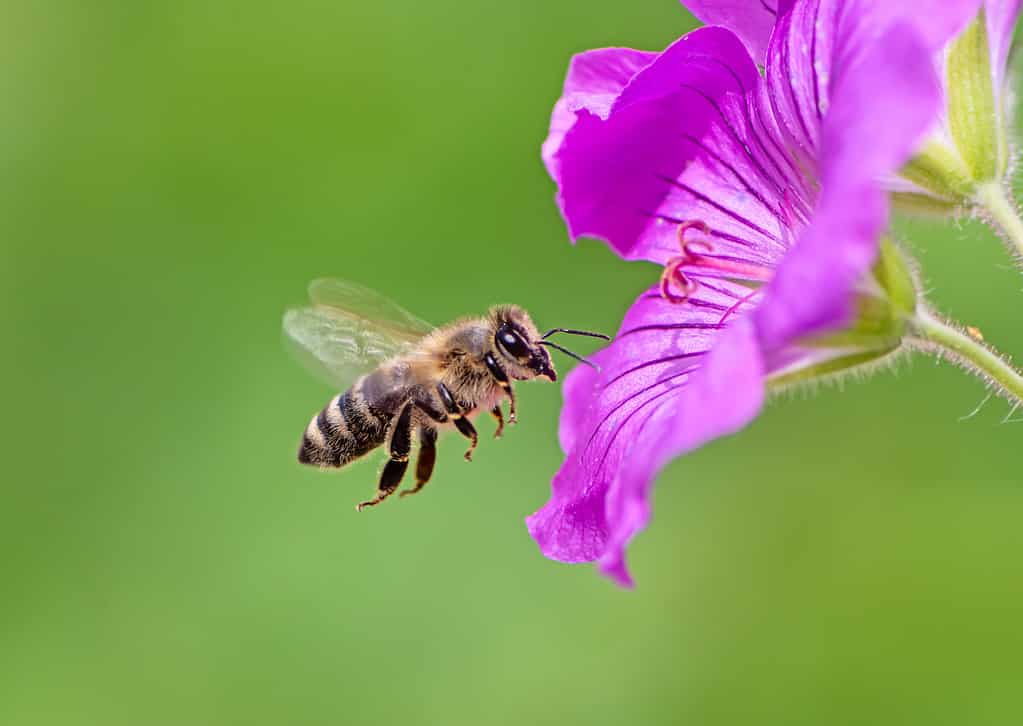
Honeybees feature golden yellow or brown bodies with yellow and brown bands.
©iStock.com/manfredxy
The next type of bee on our list is, of course, the well-known honey bee. Honey bees are members of the Apis genus. There are currently eight surviving species of honey bees in the world today, and they are distributed across every continent except Antarctica. Although they can live in various habitats, they tend to prefer woodlands, fields, and gardens with plenty of flowers. Honey bees are typically golden yellow to golden brown oval-shaped bodies with bands of yellow and brown on their abdomens. The honey bee also has a distinctively hairy abdomen, head, thorax, and legs. Honey bees are highly social and live in communal hives, which consist of anywhere between 20,000 and 80,000 bees. However, they are all ruled by a single queen. Most of the other bees in the hive are worker bees, and they produce honey from the nectar that they ingest and process.
4. Leafcutter Bees (Megachile spp.)
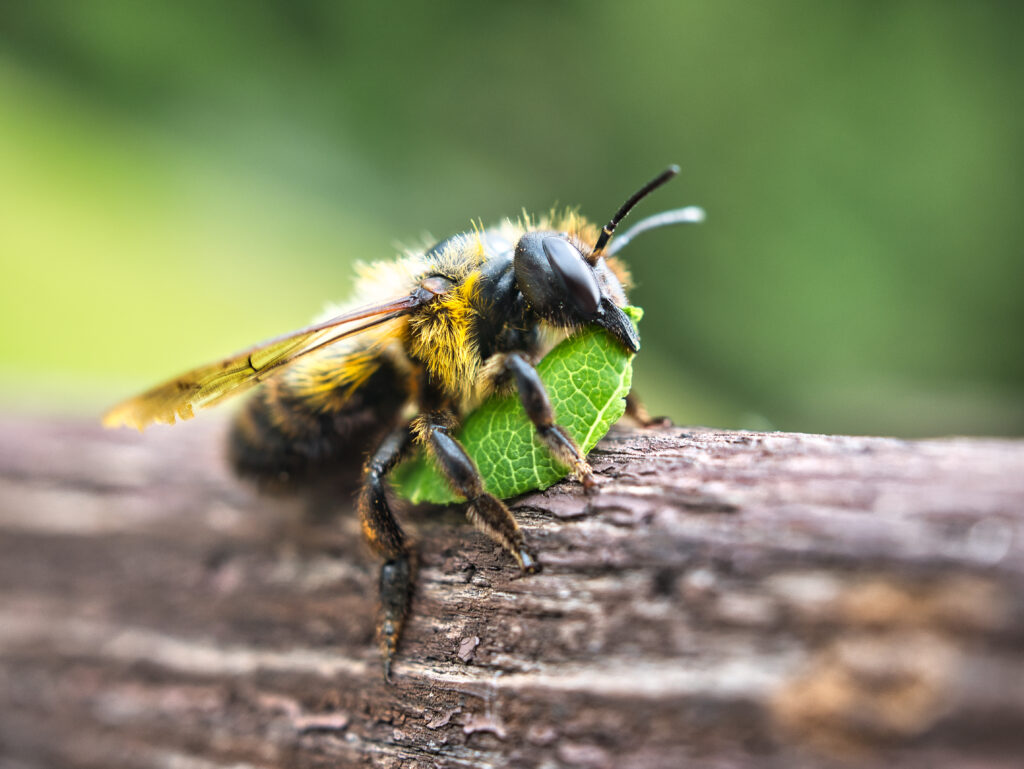
Leafcutter bees, which have orange or light brown hairs across their bodies, collect pieces of leaves for nests.
©Maurice Lesca/Shutterstock.com
Known for their ability to cut holes in leaves, leafcutter bees then collect and use the material for the construction of their nest cells. The nest itself may be made in a hollow log or in dry soil and is typically 4 to 8 inches long. Leafcutter bees are typically dark brown with some orange or light brown hairs across their back. They are around 0.7 inches long and have triangular-shaped abdomens. However, the end is pointed at females and blunt at males. Leafcutter bees are distributed across most of the world but are particularly common in North America, where they inhabit shrubland, gardens, prairies, and forests.
5. Mason Bees (Osmia spp.)

Mason bees are almost always dark-colored.
©Jennifer Bosvert/Shutterstock.com
Many bees are named because of their nesting behavior, and mason bees are no different. Mason bees are named for their tendency to nest in gaps and crevices in “masonry” products such as bricks. They are solitary bees, and the females construct their nests on their own without the help of worker bees. Mason bees are almost always dark colored — typically a metallic black, blue, or green — although there is one species that is reddish-brown. The female is larger than the male and has a scopa on the underside of its abdomen for collecting and carrying pollen. This means they are particularly effective pollinators as it allows for the pollen to easily be transferred onto flowers.
6. Mining Bees (Andrenidae family)
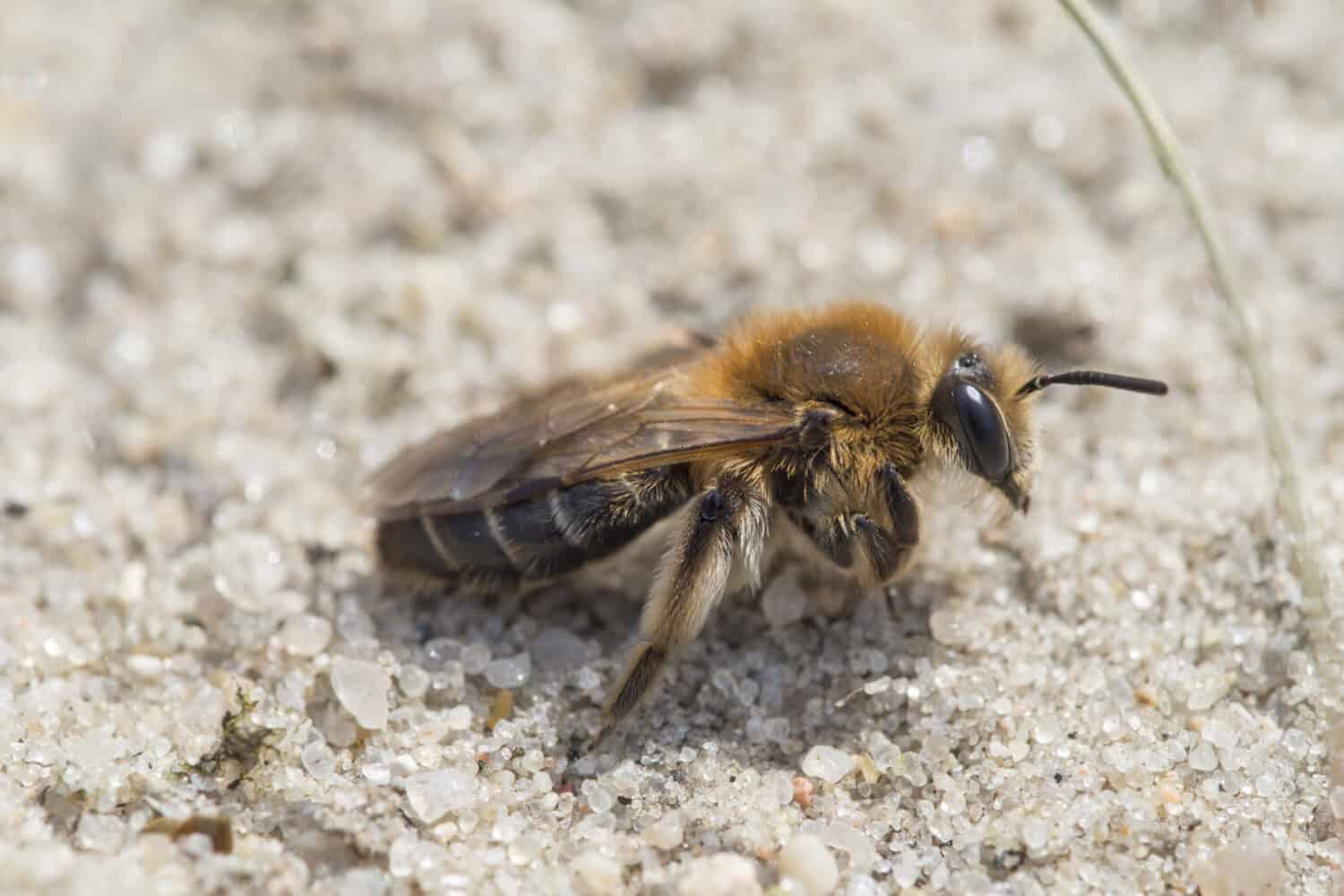
Mining bees have brown or rust-colored bodies.
©Gabi Wolf/Shutterstock.com
Known as mining bees, the Andrenidae family group are small to medium-sized bees, which create nests underground. Burrows are made in sparsely vegetated earth and form a series of tunnels. There are around 100 species of mining bees, and they occur in warm to temperate areas. They are fairly easy to identify compared to some of the other types of bees. Females are larger than males and have rust to reddish bodies covered with dense hair. Males are noticeably smaller and have brown bodies. Mining bees are also distinguished by the grooves that run inside their eyes. These grooves are called “facial fovea” and are not present on other bees.
7. Plasterer Bees (Colletidae family)
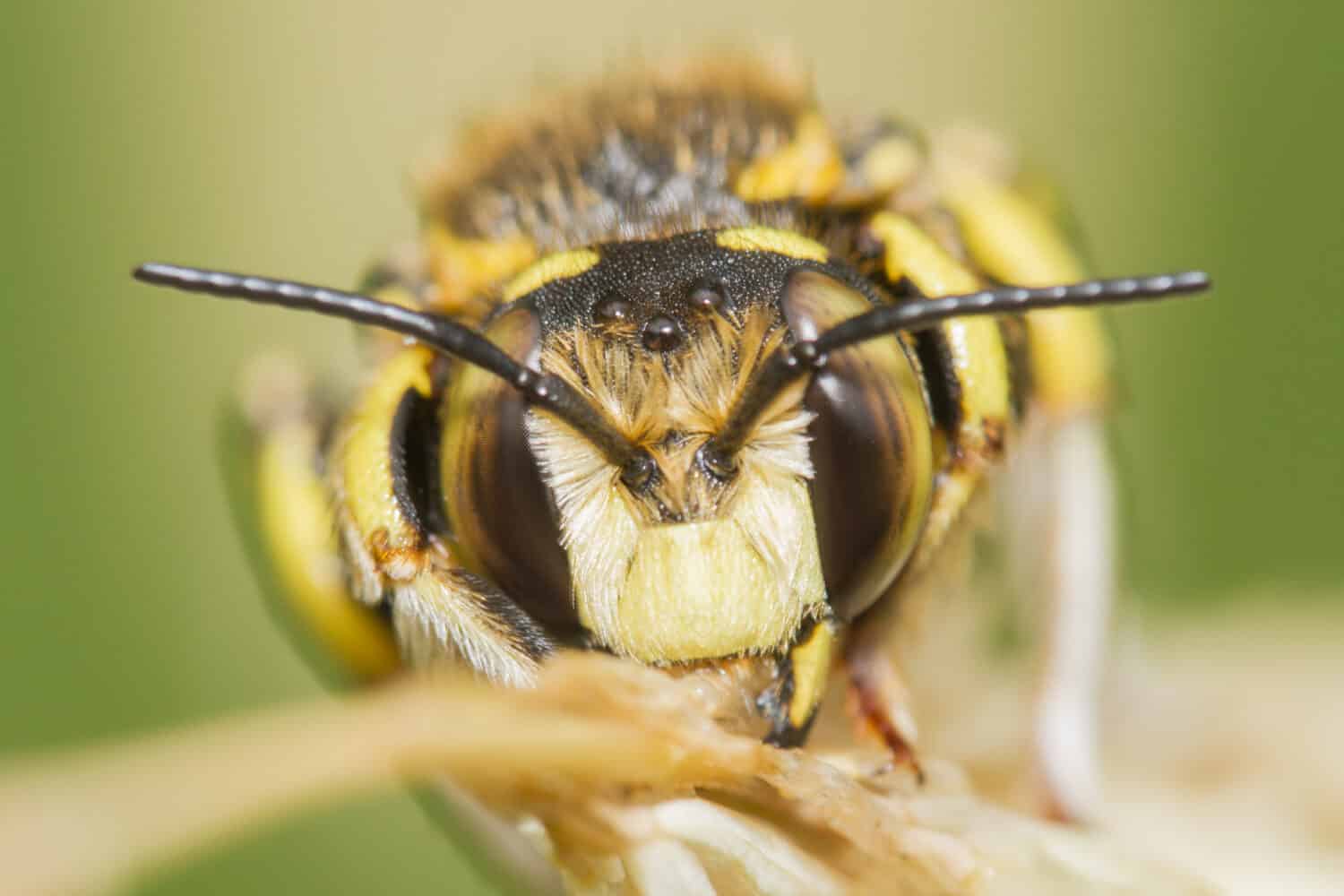
Plasterer bees have orange-brown hair and pale-colored stripes on their abdomen.
©Mircea Costina/Shutterstock.com
Another unique type of bee is the plasterer bee, which gets its name from the way that it makes its nests. Plasterer bees nest in burrows in the ground. The females create a substance that they smooth onto the walls of their nests, and when dry, it is like cellophane. Plasterer bees live in Africa, Europe, and both North and South America. This bee has a slender body that is 0.3 to 0.6 inches long and has distinctive orange-brown hair on its head and thorax. It also has pale-colored stripes on its abdomen.
8. Stingless Bees (Meliponini tribe)

Stingless bees don’t sting, though they can bite. Typically small, they have black bodies.
©Pedro Turrini Neto/Shutterstock.com
The next type of bee are stingless bees, which cannot sting as they only have a very small stinger. However, they do still have a powerful set of mandibles that they can use to bite with. Stingless bees live in tropical and sub-tropical regions across Australia, Africa, Asia, and America and are active almost year-round. They are eusocial bees and nest in hollow tree trunks and rock crevices. There are some variations between the different species. However, stingless bees are typically fairly small and have black bodies, although occasionally, some species may have small yellow markings on their backs. Most stingless bees also have hairy legs, which they use to collect and carry pollen.
9. Sweat Bees (Halictidae family)

A sweat bee features a metallic shiny body, often in black, blue, or green.
©Barbara Storms/Shutterstock.com
The final bees on our list are sweat bees, which are named because of their attraction to sweat. There are around 4,500 species of sweat bees, and they live on every continent except Antarctica. Sweat bees are largely solitary and nest in the ground in soil, clay, and occasionally in wood. They are a diverse group of bees and vary greatly in appearance. Many sweat bees, such as black, blue, or green, are dark-colored and have a metallic appearance. However, many of the males have yellow faces and thinner bodies than females. Despite this, their attraction to sweat is the most reliable way to identify them!
Summary of 9 Types of Bees and How to Identify Each
Here’s a recap of the nine bee types we took a look at and their distinguishing features.
| Number | Bee | Scientific Classification | Identifying Features |
|---|---|---|---|
| 1 | Bumble Bees | Bombus spp. | Characterized by plump and furry appearance; most have alternating bands of black and yellow on their abdomens |
| 2 | Carpenter Bees | Xylocopa spp. | Usually entirely black and have smooth and shiny bodies |
| 3 | Honey Bees | Apis spp. | Typically golden yellow to golden brown oval-shaped bodies with bands of yellow and brown on their abdomens |
| 4 | Leafcutter Bees | Megachile spp. | Usually dark brown with some orange or light brown hairs across their backs |
| 5 | Mason Bees | Osmia spp. | Almost always dark colored (typically a metallic black, blue, or green) |
| 6 | Mining Bees | Andrenidae family | Distinguished by the grooves called “facial fovea” that run inside their eyes |
| 7 | Plasterer Bees | Colletidae family | Distinctive orange-brown hair on their heads and thoraxes |
| 8 | Stingless Bees | Meliponini tribe | Typically fairly small with black bodies and very small stingers |
| 9 | Sweat Bees | Halictidae family | Attraction to sweat; many are dark-colored and have a metallic appearance |
The photo featured at the top of this post is © Jennifer Bosvert/Shutterstock.com
Thank you for reading! Have some feedback for us? Contact the AZ Animals editorial team.






